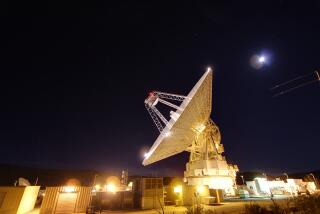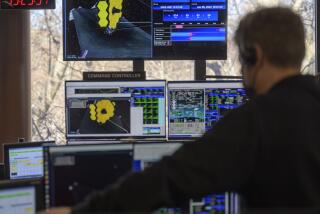With Shrinking Staff, Shrinking Budget, NASA Faces New Woes : Space: Agency’s acronym converted to ‘Not A Soul Around.’ Shuttle safety and future of entire program at issue.
CAPE CANAVERAL, Fla. — When NASA employees trudged to yet another retirement party this spring, the loudest applause wasn’t for the guest of honor, one of 1,430 who took the space agency’s latest buyout. It was for a joke.
Q. What does NASA stand for nowadays?
A. Not A Soul Around.
Sure, it’s funny. But for those leaving and those left behind, it’s also sad--and frightening.
Many worry that a shrinking staff and budget may jeopardize space shuttle safety and, ultimately, the future of the entire U.S. space program.
“You know, we’re fixing to launch two vehicles here, theoretically within a couple weeks of each other. You can’t do that kind of stuff if you’re going to reduce your people to nothing,” said John Young, special assistant for engineering, operations and safety at the National Aeronautics and Space Administration.
“Maybe you can get around it by spreading the launches out,” Young said. “But I have never seen anybody stand up or be man enough to do that. And until you do that, you can’t reduce people without introducing a lot of risk because you just work people too hard.”
Young ought to know: He’s the only person in the world to fly in space six times. He walked on the moon in 1972 as Apollo 16 commander and commanded the first shuttle flight in 1981.
Discovery is due to blast off June 8, Atlantis from June 19 to June 24. Depending on how long Discovery flies, it could be the shortest gap between U.S. human space missions.
What’s more, Endeavour is supposed to blast off July 20. That would be three shuttle launches in six weeks.
Atlantis needs to pick up NASA astronaut Norman Thagard and two Russian cosmonauts at Russia’s space station, Mir, thus the rush. The shuttle cannot leave before the third week of June because of extensive remodeling planned by the Russians at Mir, including the arrival of a new laboratory module.
To prevent the Atlantis-Mir docking from sliding into July--it’s the first of seven such dockings--NASA is considering trimming Discovery’s satellite-delivery and research mission from eight days to five.
NASA hasn’t shortened a shuttle flight for scheduling purposes since right before the 1986 Challenger accident, which killed all seven aboard.
Shuttle managers insist that there are no similarities between then and now. They point to the 43 safe shuttle flights since the Challenger accident.
Nonetheless, more than 500 NASA civil service jobs and nearly 4,000 contractor jobs have been eliminated from the shuttle program since 1992 (fewer than 25,000 shuttle jobs remain) and funding has plummeted nearly $1 billion.
More cuts were announced Friday.
To minimize potential layoffs, NASA offered buyouts to veteran employees last year and again this year. Altogether, 2,608 NASA civil service workers took advantage of the deal, which compensated them for retiring or resigning. The 165 who left Kennedy Space Center at the end of March as part of the second buyout represented 4,518 years of experience.
“If that’s not a brain drain, I don’t know what is,” said Kennedy director Jay Honeycutt, one of those thrust into new jobs. His predecessor, Robert Crippen, Young’s co-pilot on the first shuttle flight, quit in January in part because of concern over the rate of change.
NASA is down to 21,100 employees nationwide and a $14-billion annual budget. Of that amount, $3 billion is spent on the four shuttles and $2 billion on the planned international space station.
The space agency’s annual budget is expected to slip to $13 billion by the year 2000 to meet President Clinton’s call for a $5-billion cut.
NASA Administrator Daniel Goldin said by the time it’s over, NASA will be “a profoundly different agency . . . better than ever.”
But he was not so optimistic about cuts that the House approved last week. NASA and its contractors stand to lose at least 40,000 jobs nationwide, including up to 3,000 at the Jet Propulsion Laboratory in Pasadena, under that GOP plan.
“I want to tell you I have had it,” an angry Goldin said Thursday. “That [additional congressional] cut is 20,000 jobs. Well, maybe they ought to cancel the space program. Then we could all sit in the bleachers and watch the rest of the world go by. Japan’s space budget is increasing. . . .
“What everybody wants is road kill,” Goldin said. “And the latest road kill is the space station. They say: ‘Dan, we want to see you cut a NASA center.’ That is a bunch of crap. . . . “If this happens, there [are] going to be major, major cuts in programs and capability,” he added. “We are going to have to eliminate an enterprise from NASA. We are not going to be able to satisfy the Space Act of 1958, and we are not going to satisfy future generations.”
Some question even NASA’s current staffing levels.
“There’s a point at which there’s not going to be any human space exploration program and darned little any other kind if they keep going the way they’re going,” Young warned at a local Space Congress meeting in April. “You’ll have a balanced budget, but there won’t be anybody in space, I’ll guarantee that.”
“There’s a limit to where we all ought to stand up and say, ‘Whoa!’ ” Young added. “As far as I’m concerned, ‘Whoa’ is now.”
The Aerospace Safety Advisory Panel, in its annual report released in March, vowed to continue scrutinizing “the safety impact of severe budget cutbacks and the departures of key personnel, particularly on labor-intensive operations such as space shuttle processing.”
Shuttle workers are, indeed, making mistakes. But it’s difficult, if not impossible, to pinpoint all the causes.
Endeavour, for instance, blasted into orbit in March minus some parts. Three experienced shuttle workers certified that washers had been installed on four bolts when they hadn’t. Why? Complacency and “over-familiarity” with the job, said shuttle operations director Bob Sieck.
“Were they also concerned about other things at the time?” Sieck asked, referring to cutbacks. “We don’t think so, but it could have been a contributing factor.
“It increases the degree of difficulty for you to do your job if you’re distracted with this other stuff. I mean, it has to.”
More to Read
Sign up for Essential California
The most important California stories and recommendations in your inbox every morning.
You may occasionally receive promotional content from the Los Angeles Times.










